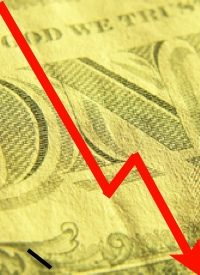
While price inflation has been reported at only four percent over the past year, the real increase (as we shall see) is much higher than that. This distortion might not be serious except that the Treasury and the Federal Reserve use the CPI as one of the measures for establishing U.S. monetary policy. The Fed has kept interest rates low based on the underreporting of CPI, and those artificially low interest rates have fueled inflation to finance the loans and have caused malinvestments, both of which have been harmful to our economy.
We have only been able to support our spending habits because of our power to borrow. When the housing market balloon burst, the power to borrow for many Americans also disappeared, leaving only huge indebtedness that they can’t afford. The real indebtedness of the U.S. government is now close to $53 trillion when future Social Security and Medicare obligations are considered, according to former Comptroller General David Walker. The debt gets worse daily. And this debt is encouraged by an intentional skewing of the CPI to downplay “price inflation,” which is caused by real inflation — the expansion of the money supply.
Calculating the CPI
The CPI is based on a “consumer basket” of goods and services purchased for consumption by households in major urban areas across the country. User fees (such as water and sewer) and sales and excise taxes are included, while income taxes and investment items (like stocks, bonds, life insurance, and homes) are not included.
Kevin Phillips, writing in the May 2008 Harper’s Magazine, reports that changes to the CPI beginning in the 1960s have increasingly distorted official statistics so as “to create a false sense of economic achievement and rectitude, allowing us to maintain artificially low interest rates, massive government borrowing, and a dangerous reliance on mortgage and financial debt even as real economic growth has been slower than claimed.”
One of the first major changes in the CPI occurred under Richard Nixon when the core CPI was established. Incredibly, the “core” excludes goods with high price volatility — including food and energy even though they are essential items. In fact, these days the biggest cost increases are in food and energy. Economic commentator Barry Ritholtz describes core inflation as “inflation ex-inflation” — inflation after inflation has been excluded.
In 1983, the Reagan administration decided that rising real estate costs were causing the CPI to be overstated, so the Bureau of Labor Statistics (BLS) substituted an “Owner Equivalent” measurement, basing housing costs on what homeowners might get if they were renting their houses. Homes were labeled an investment, and the cost of buying a home (like other investments) was no longer included in the CPI. By ignoring what was really occurring in the real estate world, the price monitors at BLS were able to lower the CPI.
“Because low inflation encourages low interest rates, which in turn make it much easier to borrow money,” wrote Phillips, the Reagan administration encouraged “the large and often speculative expansion in private debt.”
Much of this debt involved real estate and led to poor investments, which went bad between 1989 and 1992 in the savings-and-loan, real estate, and junk-bond scandals. Today, history is repeating itself as more and more homeowners who over-borrowed on their mortgages lose their homes.
The 1983 substitution of “owner equivalent rent” for real home-ownership costs, according to Phillips, “served to understate or reduce [price] inflation during the recent housing boom by 3 to 4 percentage points.”
Under the first President George Bush, Michael Boskin, chair of the Council of Economic Advisers, proposed further changes to the CPI to further reduce the price increases it shows. According to Phillips, “His stated grand ambition was to move the calculus away from old industrial-era methodologies toward the emerging services economy and the expanding retail and financial sectors.” However, writes Phillips, the real reason may have been “worry over federal budget deficits.” The effect was “to reduce the inflation rate [as measured by the CPI] in order to reduce federal payments — from interest on the national debt to cost-of-living outlays for government employees, retirees, and Social Security recipients.” Boskin’s recommendations, promoted by Federal Reserve Chairman Alan Greenspan, were eventually implemented in 1996 under the Clinton administration.
Under Clinton three adjustments were made, “all downward and all dubious,” according to Phillips.
Product substitution allowed one product to be substituted for another if consumers would buy the other product if the original product rose in price. (For example, hamburger could be substituted for steak if steak became too costly.)
Geometric weighting permitted a lower weighting to goods and services that were seeing a rapid price rise because with the rise in price there is a presumed reduction in consumption.
Hedonic adjustment reduced price inflation on goods and services that have been improved because of added quality. For example, as the quality of cars or computers improves, their higher sticker prices are not included in the CPI. The increased costs of improved technology are unreported. (The reverse effect is ignored in cases where the consumer pays more for inferior-quality goods or services.)
Under George W. Bush, the CPI has been tweaked further. Because the CPI didn’t account for the changes in the composition of goods bought by consumers, often in response to price changes, a chained CPI for all urban consumers (C-CPI-U) was established in 2001, cutting about 0.3 percent from the official CPI. The C-CPI-U employs a formula that reflects the effect of substitution that consumers make across item categories in response to changes in relative prices. Now decreased pork prices can be substituted for beef.
Effects of Underreporting
“Changes have been made in how we measure and account for inflation,” writes Ritholtz. “Not only do we understate inflation, but we do so in a systematic manner which has led to the current disconnect between government stats and reality.”
Economic analyst John Williams points out, “If you were to peel back changes that were made in the CPI going back to the Carter years, you’d see that the CPI would now be 3.5 percent to 4 percent higher.” That is, it would now show an annual 7.5 to 8 percent increase instead of 4 percent.
Had the real CPI increases been reported, Social Security recipients and other wage earners affected by cost-of-living adjustments would now be getting 70 percent more than they currently are.
Because core CPI excludes food and energy, government calculations often ignore these items when planning. Grains and dairy products have seen steep rises in the past few months, and oil is over $120 a barrel, affecting both the gasoline and heating costs.
Since 2002, the core rate dramatically misrepresented actual price inflation. The Federal Reserve lowered interest rates on this basis and has kept rates artificially low, spurring inflationary borrowing and harming the dollar.
According to Ritholtz, “The bottom line is that ultra low [interest] rates, and big increases in money, sent the U.S. dollar to 15 year lows, raised the costs of all goods denominated in dollars, and lowered the standard of living for many people — perhaps most — living in the U.S.”
Another area where government misreporting has completely eliminated “inflation” is from furnishings, apparel, and automobiles. According to consultant and researcher Tim Iacono, “The combination of inexpensive imported goods and relentless quality adjustments have squelched any BLS-reported price increases from these goods for many, many years now.”
“Undermeasurement of inflation,” according to Phillips, “hangs over our heads like a guillotine. To acknowledge it would send interest rates climbing and thereby would endanger the viability of the massive buildup of public and private debt that props up the American economy.” Combined public and private debt has increased from less than $11 trillion in 1987 to $49 trillion in 2007. If government were to report the real CPI, we would see increases in pensions, benefits, federal budget deficits, and interest payments. Government bailouts would overwhelm federal and state budgets and the financial sector would face greater crises.
According to Robert Hardaway, a University of Denver professor, the sub-prime lending crisis can be traced back to the 1983 decision to exclude the price of housing from CPI. Low-interest loans have tricked millions of buyers into purchasing homes they otherwise couldn’t afford.
John F. Wasik, writing in the Bloomberg Report, says: “The recently expired U.S. housing boom is continuing to strain household budgets, though little of this home-related inflation is measured by the consumer index.”
Banker and journalist Martin Hutchison, in April, reported real price inflation at close to an annual rate of 9 percent. “That is remarkably close to the inflation rate in China,” he wrote, “where the central bank is busy raising rates and squeezing financial institutions. It’s well above the rate in the eurozone, where the European Central Bank has held rates constant, without letting troubled banks run out of money. But the Fed has been cutting while prices rise.”
“The U.S. consumer price index continues to be a testament to the art of economic spin,” says Wasik. “Millions are falling behind inflation because wage increases aren’t keeping pace with the cost of medical care, lost employment benefits, homeownership expenses, energy and transportation.”
The prediction of economic doom is coming not only from conservative writers and economists, but liberals as well. Because of these negative trends, Council on Foreign Relations member and BYU professor Earl Fry predicts that by 2040 the United States will have lost its superpower status, replaced by emerging economies in China and India. Should we allow that to happen by failing to force a change in our governmental policies, the underreporting of the Consumer Price Index will have played a part in our downfall.
Dr. John Fisher teaches communications and does research in the area of mass media and political decision-making.


